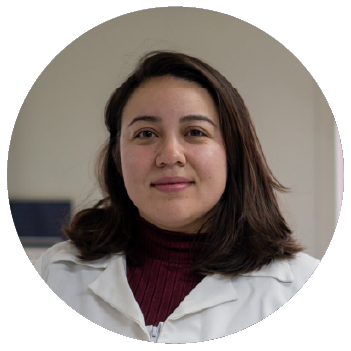
Contacto
c.belmar03@ufromail.cl
Profesor(a) Tutor
Dr. Gustavo Ciudad

Contacto
y.barrera02@ufromail.cl
Profesor(a) Tutor
Dr. Andrés Ávila

Contacto
m.lefiguala01@ufromail.cl
Profesor(a) Tutor
Dra. Carolina Shene

Contacto
f.llanos02@ufromail.cl
Profesor(a) Tutor
Dr. Carlos Muñoz

Título/Grado
Ingeniero Civil Electrónico, UTFSM
Magíster en Física Médica, UFRO
Contacto
jaime.guarda@ufrontera.cl
Profesor(a) Tutor
Dra. Olga Rubilar
Financiamiento
Beca Postgrado UFRO

Título/Grado
Ingeniero Civil Ambiental, UFRO
Contacto
f.williams01@ufromail.cl
Profesor(a) Tutor
Dra. María Eugenia González
Financiamiento
Doctorado Nacional ANID

Título/Grado
Ingeniero Civil Químico, UFRO
Contacto
p.anabalon02@ufromail.cl
Profesor(a) Tutor
Dra. Mara Cea
Financiamiento
Doctorado Nacional ANID

Título/Grado
Ingeniero Industrial, U. de La Habana
Contacto
i.paez02@ufromail.cl
Profesor(a) Tutor
Dra. Carolina Shene
Financiamiento
Doctorado Nacional ANID

Título/Grado
Ingeniero Civil Químico, UFRO
Contacto
p.sepulveda22@ufromail.cl
Profesor(a) Tutor
Dr. Edgar Uquiche
Financiamiento
Beca Postgrado UFRO

Título/Grado
Ingeniero Civil Ambiental, UFRO
Contacto
d.reyes06@ufromail.cl
Profesor(a) Tutor
Dra. María Eugenia González
Financiamiento
Doctorado Nacional ANID

Título/Grado
Ingeniero Civil Mecánico, UFRO
Magíster en Ciencias de la Ingeniería, UFRO
Contacto
b.nahuelcura01@ufromail.cl
Profesor(a) Tutor
Dra. María Eugenia González
Financiamiento
Doctorado Nacional ANID

Título/Grado
Ingeniero Civil Ambiental, UFRO
Contacto
lilian.fuentes@ufrontera.cl
Profesor(a) Guía
Dr. Gustavo Ciudad
Financiamiento
Doctorado Nacional, ANID
Titulo de tesis
Development of a new Strategy for concentrating ligninolytic Enzymes extract the Anthracophyllum discolor culture and enhancing MnP activity using forward osmosis and controlling reverse salt flux with MnSO4 as a draw solution for pharmaceutical contaminant degradation.
Contamination by emerging compounds, such as pharmaceuticals and chemicals, represents a growing environmental challenge. Bioremediation with white rot fungi, such as Anthracophyllum discolor, offers a sustainable and effective alternative. Ligninolytic enzymes produced by this fungus, (Lacase (Lac), Manganese Peroxidase (MnP) and Manganese Independent Peroxidase (MinP), are mainly responsible for the degradation of these substances. Various methods have been evaluated for the application of A. discolor in bioremediation, such as its direct use, enzyme extraction and application, and enzyme induction, concentration, and partial purification. Membrane filtration processes have been presented as a viable way of concentrating various compounds, with forward osmosis (FO) being an alternative that has low fouling and does not require external pressure or heat to be carried out. Due to the difference in this potential, the water in the feed stream migrates to the extraction solution, seeking equality between the two solutions. In this way, the feed solution can be concentrated. One of the drawbacks of this process is the phenomenon of reverse salt flux, as a percentage of salt from the DS migrates to the feed solution, which is generally desired to avoid, however, depending on the salt used in DS, the control of reverse salt flux could be beneficial for the enzymatic activity of the solution. Due to the chemical properties and osmotic potential that MnSO4 can generate, it meets the requirements to be used as DS and additionally as an inducer of enzyme production, therefore, the use of this solution could concentrate and generate an improved enzyme extract for further use. It is therefore proposed as an objective “To Develop a new strategy to concentrate a ligninolytic enzymatic extract from A. discolor culture and enhance MnP enzyme activity using forward osmosis and controlling reverse salt flux with MnSO4 as the draw solution for application in the degradation of pharmaceutical contaminants”, for this purpose, two FO membranes (CTA and TFC) will be evaluated in an experimental design with three factors: membrane orientation mode, temperatura and salt concentration, this evaluation will be carried out in distilled water. The enzyme extracts obtained (unfiltered, filtered and cultured coupled to filtration) and the efficiency in the degradation of pharmaceutical contaminants will be evaluated over time. It is expected to obtain a concentrated ligninolytic enzyme extract obtained from the culture of A. discolor through a process of concentration of FO with DS of MnSO4, controlling the reverse flux of salt to have a better activity of the enzyme manganese peroxidase and a higher efficiency in the degradation of pharmaceutical contaminants.

Título/Grado
Ingeniero Civil Ambiental, UCT
Contacto
r.mora06@ufromail.cl
Profesor(a) Guía
Dr. Gustavo Ciudad
Financiamiento
Doctorado Nacional ANID
Titulo de tesis
A immobilised multi-enzyme system of ligninolytic enzymes extract from the White rot fungi Anthracophyllum discolor for the removal of pharmaceutical contaminants.
The presence of emerging contaminants (EP) in water and their wide distribution is a major problem for the health and safety of people and environments. Within this group of pollutants, antibiotics and pharmaceuticals are of most significant concern due to their stability, persistence, and wide distribution. The mere presence of these contaminants in wáter generates alterations in microbial communities and promotes the development of resistance to antimicrobial drugs by pathogenic organisms. Regarding the relevance and complexity of this problem, several types of treatment have been developed, but their effectiveness is limited. In the search for tools for bioremediation, ligninolytic enzymes from white rot fungi have been used. These enzymes have been shown to be efficient in the removal of a wide range of emerging contaminants, however, the use of free enzymes complicated the recovery and reuse of the enzymes complicated. The use of free enzymes leaves them susceptible to denaturation. Considering the above, the aim is to develop an multi enzyme system in which the enzyme extract produced in the cultivation of Anthracophyllum discolor is immobilised for pharmaceutical compound removal; the support to be used will be nanocellulose functionalised with polydopamine. Functionalisation with this polymer allows the limitations of nanocellulose as immobilisation support and made compatible with this enzyme system, the functionalization protects the support from enzymatic activity, as well as conferring properties to the material that favour the immobilisation of the enzyme system produced by the fungus. The development of the system first involves the hydrolysis and functionalisation of the support, second the immobilisation of enzyme extract through random co-immobilisation. The development of the immobilised enzyme system is intended to create an enzyme system that enables the effective removal of pharmaceutical pollutants from wastewater streams.

Título/Grado
Ingeniero Civil Ambiental, UCT
Contacto
c.guzman09@ufromail.cl
Profesor(a) Guía
Dr. Gustavo Ciudad
Financiamiento
Doctorado Nacional, ANID
Titulo de tesis
Develop a process In situ ammonium harvest as green energy carrier from anaerobic digestion of aquaculture sludge through a forward osmosis process (AD-FO-[NH4+]).
Anaerobic digestion (AD) is a process that involves the degradation of organic matter by the metabolic action of a microbial consortium in the absence of oxygen with an energy requirement of 0.43kWh/m3, which is traduced in 58% less than the requirement energy of the treatments biological aerobic. However, its application is limited to waste with a high nitrogen content for the inhibition that generates the accumulation of ammonia nitrogen produced in the AD process, as is the case of aquaculture sludge. Forward osmosis (FO) is an emerging technology for water recovery. This process is driven by the osmotic pressure differential between two solutions separated by a semi-permeable membrane, through which water is transported without needing external pressure. The FO process applied to real wastewater using a thin-film composite membrane (TFC) showed low rejection of the ammonia nitrogen, which evidenced its diffusive capacity. Therefore, the doctoral thesis proposal developing an in situ ammonium harvest process as a green energy carrier from anaerobic digestion of aquaculture sludge through a forward osmosis process (AD-FO—[NH4+]) and optimising the treatment of aquaculture sludge. The research will involve a comprehensive design and evaluation of an integrated anaerobic digestion and direct osmosis (AD-FO) process. This process will allow for the continuous concentration of aquaculture sludge and the simultaneous harvest of ammonium. The effect of reverse salt flux in the anaerobic reactor will be rigorously evaluated through analysis of the biochemical potential of methane and specific methanogenic activity (BMP and SMA). A thorough technical and economic evaluation of the (AD-FO-[NH4+]) process for producing green hydrogen from aquaculture sludge will be conducted, from a theoretical concept to pilot plant design and economic assessment. Finally, it is expected to obtain an optimal anaerobic digestion of aquaculture sludge and a solution rich in ammonium through an integrated (AD-FO-[NH4+]) process, obtaining an energy carrier.

Título/Grado
Ingeniero Civil en Biotecnología
Contacto
k.penailillo01@ufromail.cl
Profesor(a) Guía
Dra. Cristina Diez
Profesor(a) Co-Guía
Dr. Edgar Uquiche
Financiamiento
Doctorado Nacional, ANID
Título de tesis
Evaluation of the production and extraction of microbial biosurfactants by solid fermentation from waste material from olive oil extraction industry
Biosurfactants are secondary metabolites with amphiphilic properties, meaning they have both hydrophobic and hydrophilic regions in their structure. These molecules have significant surface and interfacial activity, as they can reduce the surface tension of water and other fluids, and some also exhibit emulsifying properties. Biosurfactants are characterized by low toxicity, high biodegradability, and stability under various conditions, making them suitable for a wide range of applications in agriculture, pharmaceuticals, and cosmetics. Research has focused on the development and optimization of bioprocesses, including the evaluation of new biosurfactant-producing strains, partial or total substitution of substrates, and the assessment of extraction techniques. Several microorganisms have been studied for biosurfactant production. At the Center of Excellence in Biotechnological Research Applied to the Environment (CIBAMA) laboratories, three microbial strains capable of producing biosurfactants have been isolated from a biopurification system and identified as: Pseudomonas marginalis C9, Bacillus amyloliquefaciens C11, and Streptomyces lavendulae C27. These strains have been studied using olive oil as a substrate. However, there is potential to replace olive oil with alperujo a waste material from olive oil extraction industry, which contains unextracted oil, high moisture content, and a significant organic load, among other characteristics. Biosurfactants are produced by submerged fermentation from complex media. However, it has disadvantages related to foam production and increased viscosity. Another option is solid-state fermentation, as it offers several advantages for biosurfactant production such as lower water consumption, lower risk of contamination, and improved metabolite production. Another critical stage that can influence the final biosurfactant yield is the extraction process. Chemicals are used to extract biosurfactants. One alternative method is the use of supercritical fluid extraction, which enables efficient and selective collection of the bioproduct by controlling temperature and pressure. One commonly used fluid in this process is CO2, as it is effective for extracting nonpolar substances. The use and proportion of CO2 in the extraction process should be investigated to optimize extraction conditions. Ethanol is a popular cosolvent in supercritical CO2 extraction. This study aims to evaluate the production of biosurfactants in cultures of Pseudomonas marginalis C9, Bacillus amyloliquefaciens C11 and Streptomyces lavendulae C27 using alperujo as a substrate in a solid medium. The strain with the highest biosurfactant production will be selected for a process optimization, and the extraction of biosurfactants will be evaluated using supercritical CO2. First, a characterization of the alperujo will be carried out to be used in the next activities. Biosurfactant production will be carried out by submerged fermentation in a culture medium with alperujo. Biosurfactant production will be evaluated by measuring surface tension and oil displacement test, and microbial growth with these results a microbial strain will be selected.

Título/Grado
Ingeniero Civil Ambiental
Contacto
j.bocaz01@ufromail.cl
Profesor(a) Guía
Dra. María Eugenia González
Profesor Co-Guía
Dr. Eulogio Castro, Universidad de Jaén (España)
Financiamiento
Doctorado Nacional, ANID
Título de tesis
Development of activated biochar from agroindustry waste as a Cu/Ni support for the production of hydrogen from formic acid through dehydrogenation Resumen de Tesis
Hydrogen (H2) is a green fuel with the potential to replace fossil fuels. Due to the high energy requirements for its storage, hydrogen storage liquids (HSLs) are used as a safe and scalable option. Formic acid (FA) is one of the most promising hydrogen storage liquids (HSLs) for use in fuel cells, given its high volumetric capacity, stability, and ease of transport and storage. The dehydrogenation of formic acid (FAD) is the necessary reaction to obtain H2 from FA, and it is accelerated with the action of an appropriate catalyst. Pd, Pt, Au, and Ru are among the frequently used metals. However, Cu has been suggested as a viable alternative due to its selective nature. It tends to promote the dehydrogenation pathway rather than dehydration, making it favorable for certain reactions. Additionally, Cu is advantageous due to its relatively low cost compared to other metals. On the other hand, Ni has been frequently utilized as a metal that participates in the electron flow between metals, thereby enhancing the catalytic activity of FA dehydrogenation (FAD). To increase the number of adsorption sites, catalysts are often supported on porous materials, such as carbonaceous materials. Among these, biochar represents a viable option as it is synthesized from renewable and low-cost sources, and its structure can be improved through activation and doping methods, which increase the surface area and availability of active sites for catalysis, respectively. Therefore, the objective of this study is to obtain a selective catalyst for hydrogen production through formic acid (FA) dehydrogenation, based on Cu/Ni supported on activated biochar derived from hazelnut shells. Firstly, the hazelnut shell (Corylus avellana) will undergo pyrolysis after prior characterization. KOH will be used as an activator and urea as a dopant to produce activated and functionalized biochar. An experimental design will be employed, with the factors being pyrolysis temperature, residence time, and the ratio of urea to biomass, while the responses will be biochar surface area (m2 g-1) and its final nitrogen content (%m). Subsequently, for the biochar samples that yield optimal responses, Ni(NO3)2·6H2O and Cu(NO3)2·3H2O will be incorporated via wetness impregnation using two parallel methods: (a) sodium borohydride (NaBH4) will be applied as a reducing agent, varying the molar ratio between Cu and Ni salts, (b) impregnated biochar samples will be calcined in an N2 atmosphere, employing an experimental design and varying the reduction temperature and molar ratio of metal salts. In both methods (a and b), the catalytic activity (TOF, h-1) and the final metal loading in the catalyst (%m) will be determined.

Título/Grado
Ingeniero Civil Industrial mención Bioprocesos
Contacto
j.cumilaf01@ufromail.cl
Profesor(a) Guía
Dra. Mónica Rubilar
Profesor Co-Guía
Dr. Andre Brodkorb, TEAGAST, Irlanda
Financiamiento
Doctorado Nacional, ANID
Título de tesis
Evaluation of the structure and in vitro digestibility of alginate/hemp protein as a vegetable oil encapsulation material by ionic gelation.
According to the results reported by the National Health Survey, in Chile more than 70% of the population over 15 years of age is overweight or obese. This is mainly due to inadequate eating behaviours in the population that imply a health risk because they promote an increase in the rates of chronic non-communicable diseases, which suggests looking for strategies for a healthy food intake. Many health foods possess bioactive compounds that are known to confer health benefits because they are able to modulate metabolic processes, however, their instability to processing, storage and variations in pH, temperature, light, oxygen and ions limits their use. Therefore, conferring protection to these compounds allows safeguarding their bioactive properties, improving their shelf life and giving a higher added value for their commercialization. Polyunsaturated fatty acids have been the subject of interest due to their ability to improve human health because they would have an anti-inflammatory, anticancer and antihypertensive effect. For the encapsulation of bioactive compounds, alginate has been widely studied, which allows it to have a basis in the development of capsules, however, recently the use of alginate with the addition of proteins as a structuring of the wall of encapsulation systems becomes interesting due to that better results can be achieved in encapsulation efficiency and stability during gelation, storage and digestibility processes. Among the promising proteins, hemp protein has attracted attention for its properties for the design of encapsulation structures due to a capacity for oil absorption and stabilization of emulsions better than other vegetable proteins such as soybean and pea, and may even improve the encapsulation capacity of oils and fat-soluble compounds in systems with alginate. However, not only these properties are interesting to be analyzed, from a nutritional point of view, in in vitro digestion tests, which presented a digestibility comparable to that of soy protein in the gastric phase and significantly higher in the intestinal phase in the intestinal compared to soy protein. The processing of raw materials and encapsulates, as well as foods, vary their digestibility under variations in their processing (temperature, pressure, composition and concentrations, others). Therefore, the in vitro evaluation of the performance of foods and functional ingredients of the gastrointestinal system allows obtaining results that relate not only the response to variations during processing but also the interaction between the components that constitute them. However, from the data obtained through the database, no literature has been found that describes the behaviour of alginate/hemp protein structures as wall material for the encapsulation of vegetable oil. Therefore, this study to evaluate the structure and in vitro digestibility of hemp protein stabilized O/W emulsion mixtures with sodium alginate to encapsulate vegetable oils using the ionic gelation method. This study will focus on the development of stable structures with high oil encapsulation capacity, optimized in their processing for the release and modulation of vegetable oil using static and semi dynamic in vitro digestion models.

Título/Grado
Ingeniero Civil Químico
Contacto
m.kopp01@ufromail.cl
Profesor(a) Guía
Dra. Mara Cea
Profesor Co-Guía
Dr. Marcos Larriba, U. Complutense de Madrid (España)
Financiamiento
Doctorado Nacional, ANID
Título de tesis
Production of 2,5-furandicarboxylic acid (FDCA) from Lignocellulose-derived Glucose in a One-flow Microreactor System.
There is a growing interest in developing sustainable technological processes based on biomass utilization to produce chemicals that can replace compounds derived from fossil sources. Generating economically viable processes for synthesizing chemicals from biomass sugars is a significant challenge in this field. Among the different biomass-derived compounds, 2,5-furandicarboxylic acid (FDCA) is gaining increasing attention due to its potential application as a substitute for petroleum-derived terephthalic acid in polymer production, such as polyethylene furanoate (PEF). Various strategies have been developed to efficiently produce FDCA from its precursor, 5-hydroxymethylfurfural (HMF). However, although much research and investment have been dedicated to the synthesis of FDCA, there remains limited commercial activity in this area due to the technological challenges related to the stability and isolation of the HMF. Recently, microreactor technology has shown promise in synthesizing value-added products derived from biomass thanks to enhanced mass/heat transfer and reduced reaction times. In this regard, using microreactors in series, known as one-flow systems, is proposed as an intensification process to produce FDCA from lignocellulosic-derived sugars. The general objective of this project is to develop a catalytic process for synthesizing FDCA from lignocellulosic biomass-derived glucose using a one-flow microreactor system. To achieve this objective, the project will be conducted in several steps. Firstly, a PFA capillary segmented flow microreactor will be configured, and the synthesis of HMF from glucose will be performed. Various parameters, including temperature (140-180 °C), organic/aqueous flow ratios (1-4), and solvent types (GVL, MIBK, and DMSO), will be evaluated to maximize the yield of HMF. Additionally, mass transfer studies and hydrodynamic analysis using COMSOL Multiphysics® will be conducted to examine the impact of reactor geometry on HMF yield. In the second part of the project, a stainless-steel micropacked-bed reactor filled with 5% Pt/C particles will be configured. The synthesis of FDCA will be optimized using a Box-Behnken response surface design that considers three factors: temperature (80-160 °C), pressure (1-10 bar), and gas/liquid flow ratios (1-5), to determine their influence on FDCA yield. Similarly, to further understand the process, gas-liquid-solid mass transfer resistance studies, and hydrodynamic analysis using COMSOL Multiphysics® will be performed. Finally, based on the optimal reaction conditions for HMF and FDCA synthesis, a one-flow process will be implemented to directly synthesize FDCA from sugars obtained from brewery residual biomass. Simulations using Aspen Plus V9® will be conducted to estimate the production costs associated with the FDCA synthesis. By investigating the use of a one-flow microreactor system, optimizing reaction conditions, and utilizing lignocellulosic biomass-derived glucose as a sustainable feedstock, this project aims to advance the development of an efficient and economically viable process to produce FDCA with high yields (>90%), contributing to the sustainability of the chemical industry.

Título/Grado
Ingeniero Civil Químico
Contacto
s.trigo01@ufromail.cl
Profesor(a) Guía
Dra. María Eugenia González
Profesor Co-Guía
Dr. Juan M. Romero, Universidad de Jaén (España)
Financiamiento
Doctorado Nacional, ANID
Título de tesis
Hydrogen production from formic acid obtained by microwave-assisted hydrolysis-oxidation hydrothermal treatment of brewer’s spent grain
The population, economic and industrial growth of countries has generated an increase in energy demand. This leads to an environmental and energy problem since 82% of the world’s primary energy demand is supplied by fossil fuels, which are characterized by their exhaustible nature and their greenhouse gas emissions (GHGs). In this context, the search for new energy sources has been promoted, among which hydrogen (H2) an energy vector, due to its high energy content (142MJ/kg) and its combustion generates only water vapor. However, this compound is not found in free form in the earth, but is mainly bound to other elements (carbon and oxygen), so its production requires a transformation process. At present, H2 is mainly produced worldwide through the steam methane reforming (SMR) process, although the raw material used is of fossil origin. Storage and transportation play an important role in H2 economics, being even comparable to that of production. Conventional storage methods are mainly compression and liquefaction, which increase H2 density. However, these processes are energy-intensive, require special containers and inevitably lead to H2 losses during storage. In response to this, organic liquid hydrogen carriers (LOHC) have emerged, which are organic liquids capable of receiving and releasing hydrogen through the catalytic reactions of hydrogenation and dehydrogenation, respectively. The most studied LOHC systems have high storage capacities, but they are toxic, require harsh thermodynamic conditions and are of fossil origin. In recent years, formic acid (FA) has been found to have interesting physical properties that make it a promising LOHC. However, it is worth noting that the majority of this compound is currently derived from fossil raw materials. Nonetheless, research has shown that FA can be obtained from biomass through acid hydrolysis and/or oxidation processes. This presents a promising avenue for the production of FA using renewable biomass feedstocks instead of relying solely on fossil resources. This work aims to evaluate the dehydrogenation of formic acid obtained from a hydrothermal treatment of microwave-assisted hydrolysis-oxidation of brewer’s spent grain (BSG) for hydrogen production, in order to evaluate whether the presence of by-products in the obtained FA solution influences the production of H2, particularly in the dehydrogenation of FA. For this purpose, the BSG will be characterized by determining its moisture, volatile content, fixed carbon and ash through a proximate analysis. The total carbon, hydrogen, nitrogen and sulfur content will be determined by elemental analysis, while the content of polysaccharides and monosaccharides will be determined using procedures established by the National Renewable Energy Laboratory (NREL).

Título/Grado
Ingeniero Civil Electrónico
Contacto
p.cachana02@ufromail.cl
Profesor(a) Guía
Dra. Carlos Muñóz
Profesor(a) Co-Guía
Dr. Christian Antileo
Financiamiento
Doctorado Nacional, ANID
Título de tesis
Efficient and sustainable long-term partial nitrification in a laboratory-scale continuous activated sludge reactor using advanced control and optimization strategies.
In many industries, a large amount of pollutants is generated and deposited in wastewater, and one of the most complex ones is nitrogen, which has a significant impact on aquatic ecosystems and human health. It is necessary to reduce nitrogen levels, and for this purpose, legal regulations are established in each country. In Chile, Supreme Decree 90 sets the maximum allowable limit for total nitrogen in wastewater at 50 mg/L. In the field of wastewater treatment, various methods have been tested to remove nitrogen, and the most suitable option in terms of cost and waste reuse is biological nitrogen removal, which consists of two stages. The first stage is nitrification, which involves the transformation of ammonium (NH+4) to nitrite (NO−2) in the presence of oxygen. This process is carried out by Nitrosomonas bacteria, also named ammonia-oxidizing bacteria (AOB). Simultaneously in this stage, nitrite is further converted to nitrate (NO−3) by the action of Nitrobacter bacteria, also called nitrite-oxidizing bacteria (NOB). The second stage is denitrification, which occurs in the absence of oxygen and involves the transformation of nitrate to nitrite, then to nitrous oxide (NO), nitric oxide (N2O), and finally to gaseous nitrogen (N2). However, this process requires reconverting the nitrate to nitrite, which uses organic matter and involves high costs due to energy consumption, resulting in an inefficient process. Therefore, the technique of partial nitrification has been proposed to leverage the traditional biological nitrogen removal process. This technique aims to favor the conversion of ammonia to nitrite while avoiding the conversion of nitrite to nitrate, which saves energy in aeration and reduces the demand for organic matter. However, maintaining optimal conditions for the growth of AOB and the inhibition of NOB poses complex challenges that require advanced control techniques.
The aim of this work is to develop advanced control-based optimization strategies to achieve efficient and sustainable partial nitrification for over two months in a laboratory-scale continuous activated sludge reactor. For this purpose, a pilot plant for biological nitrogen removal equipped with a CSTR reactor will be used, featuring sensors for pH, dissolved oxygen, and hydraulic retention time (HRT), each with their respective control valves, such as an oxygen pump, a carbonate pump, and a flow regulator. The methodology for this study includes several stages. Firstly, regulatory control will be developed through robust controllers for pH, dissolved oxygen, and HRT, aiming to follow a wide range of reference values. These controllers will be designed and tested experimentally to review the limitations and speeds of each. Since we will be working with a continuous reactor, it’s necessary to determine an operating point that favors partial nitrification. For this, optimization techniques will be applied to the ASM1 model. Subsequently, three operating points will be examined to verify their feasibility in the laboratory, and the best candidate will be determined based on efficiency, implementation costs, and operating point sensitivity.

Título/Grado
Ingeniero Mecánico, UFRO
Magíster en Ciencias de la Ingeniería mención Ingeniería Mecánica
Contacto
camila.silva@ufrontera.cl
Profesor(a) Guía
Dra. Mara Cea
Financiamiento
Doctorado Nacional, ANID
Título de tesis
Development of a dye-sensitive solar cell based on iron oxides/biochar composites and Antarctic bacterial pigments.
Dye-sensitized solar cells (DSSCs) are the third generation of photovoltaic devices capable of transforming solar radiation into electrical energy. In recent years, research on sensitizers in DSSCs has been focused on the production and application of pigments produced by extremophilic microorganisms. The main drawback of bacterial pigment is associated to their photovoltaic which is still low compared to the yields obtained in cells sensitized with pigments of synthetic origin. The counter electrode is also an essential component in DSSCs because it acts as a catalyst. Regarding to the catalyst types, the platinum is considered the most used in DSSC. However, these materials have disadvantages, in this context, activated carbon has demonstrated to be an option to replace the traditional platinum catalyst. The objective of this project is to develop an efficient and stable dye sensitive solar cell bases in a counter electrode prepared iron oxides/biochar composites and a photoanode sensitized with antarctic bacterial pigments. The expected results are to develop a catalyst applied in the counter electrode of a DSSC that allows improving the photoelectric conversion performance in a cell sensitized with bacterial pigments, this from the valorization of agricultural waste, giving an added value to the residual biomass.

Título/Grado
Ingeniero Civil en Biotecnología, UFRO
Contacto
v.bascur01@ufromail.cl
Profesor(a) Guía
Dra. Mariela Bustamante
Financiamiento
Doctorado Nacional, ANID
Título de tesis
Effect of chia mucilage (CM) and biogenic SPIONs synthesized using CM (CM- SPIONS) on the survival and viability of probiotic bacteria encapsulated by spray drying in cross-linked alginate matrices
Probiotic bacteria (PB) of the Lactobacillus and Bifidobacterium genera are the most widely used in the food industry due to their health benefits. The products must guarantee a minimum viable concentration of PB after its passage through the GIT, overcoming adverse conditions; To solve these drawbacks, technological developments such as encapsulation have been implemented to improve the viability PBs. In this context, spray drying (SD) has proven to be effective for PB encapsulation, however, the problem with this type of drying is the inactivation of PBs, the choice of a suitable encapsulating solution (ES) is the most relevant process to increase survival during drying, because it can minimize the effects of the thermal treatment. As part of an ES, a method of PB encapsulation by SD in cross-linked alginate matrices has been proposed. Another compound used is chia mucilage (CM), which protects the PBs in the SD. Superparamagnetic iron oxide nanoparticles (SPIONs) have improved PB survival, but have not been used in the encapsulation of PB by SD in cross-linked alginate matrices and, in turn, have not been biosynthesized using CM extract. Therefore, the objective of this proposal is to effect of chia mucilage (CM) and biogenic SPIONs synthesized using CM (CM-SPIONs) on the survival and viability of probiotic bacteria (PB) encapsulated by spray drying (SD) in cross-linked alginate matrices under different conditions environmental and gastrointestinal. In the first stage, the effect of reaction parameters for the biogenic synthesis (BS) of SPIONs using CM extract will be evaluated. In the second stage, the effect of CM and SPIONs on the survival of PB encapsulated by SD in cross-linked alginate matrices will be evaluated. In the third and final stage, the effect of CM and SPIONs on the viability of PB encapsulated by SD in cross-linked alginate matrices will be evaluated under different conditions. The results of this research, it is expected to develop a fast, continuous and reproducible method to obtain an optimized product with high viability; at high process temperatures and simulated adverse conditions.

Título/Grado
Ingeniero Civil en Biotecnología, UFRO
Magister en Ciencias de la Ingeniería mención en Biotecnología
Contacto
p.paredes03@ufromail.cl
Profesor(a) Guía
Dra. Carolina Shene
Financiamiento
Doctorado Nacional, ANID
Título de tesis
Design of a strategy for the optimized production of a squalene-enriched oil by Thaustochytrium RT2316-13
Squalene is a hydrocarbon with several benefits to human health; it has been studied to prevent some diseases such as cancer. In addition, it has applications in the cosmetic and pharmaceutical industry. The content of squalene in olive oil is low, and the production of olive oil is associated with several adverse effects on the environment that also question its sustainability. Therefore, microbial squalene is an alternative that needs to be studied. Thraustochytrids belong to a group of protists widely distributed in diverse water environments. Some marine strains are capable to produce squalene. Thraustochytrids are aerobic heterotrophic microorganisms that consume various sources of carbon and nitrogen, although most of the experimental studies had used glucose or glycerol and yeast extract as carbon and nitrogen sources, respectively. The use of culture media based on industrial wastes has also been studied giving good results for the production of lipids, and squalene, and in some cases the results are comparable to those obtained with laboratory culture media. Squalene is an intermediate product in the sterol pathway; so in microorganisms that do not accumulate squalene, the squalene epoxidase (EC. 1.14.14.14.17) oxidizes squalene to produce lanosterol. One way to prevent this reaction is through the use of terbinafine, an antifungal compound, that inhibits squalene epoxidase; another strategy is using anaerobiosis phases in the culture. One of the aim of this proposal is to reduce the costs for the production of an squalene-enriched oil using Thraustochytrium RT2316-13. Another objective is to induce the accumulation of squalene. Finally the production of squalene in an airlift reactor will be studied. This work will increase the knowledge on Thraustochytrium sp. grown on low cost carbon and nitrogen sources for future scale-up.

Título/Grado
Ingeniería Mecánica, UFRO
Contacto
alvaro.gonzalez@ufrontera.cl
Profesor(a) Guía
Dra. María Eugenia González
Financiamiento
Doctorado Nacional, ANID
Título de tesis
Synthesis of carbon nanostructures through hydrothermal carbonization of black liquor kraft lignin: potential use in supercapacitors
The proposal is oriented at the use of industrial waste from the pulp mill paper industry, this industry produces high amounts of lignin as waste that is recycled as a low calorific fuel to produce electricity from steam. However, due to phenolic structure that lignin possesses makes it a desirable candidate for the synthesis of high value products, through chemical or thermochemical transformations, such as hydrothermal carbonization (HTC). HTC process in the last decade has gained momentum in research. Carbon nano-structures produced by HTC, have attracted the attention of the scientific community. Currently the high energy consumption has explored new sources of energy in search of improvement of this storage, new materials have been proposed help energy storage in batteries and supercapacitors. The current research is focused on the application of nanostructures in the desing of electrodes of these supercapacitors. This project proposes use the lignin contained in the black liquor to synthesize nanostructures through hydrothermal carbonization, and to evaluate the product as supercapacitors. The experiments will be perform a factorial experimental design that will be used in hydrothermal carbonization of lignin. The electrochemical performs of nanostructures from lignins will be study by an electrochemical impedance spectroscopy (EIS) using a high current potentiostat/galvanostat.

Título/Grado
Ing. en Alimentos, UFRO
Contacto
s.gonzalez02@ufromail.cl
Profesor(a) Guía
Dra. Mónica Rubilar
Financiamiento
Doctorado Nacional, ANID
Título de tesis
Bigel systems enriched with polyunsaturated vegetable oils and microencapsulated astaxanthin as a substitute for saturated fatty acids and trans fats
The elastic properties of hard (animal) fats are important in producing texture, spreadability, shelf life, and mouthfeel of foods. To eliminate trans fats and to reduce saturated fats in foods oleogel, emulgel and bigel technology have been developed. Gel technologies are soft matter systems widely used in cosmetic applications and food products. The interacting components and the resulting characteristics of a system replacing animal fat are vital to recognize the right combination of gelling agents, vegetable oils and also process conditions. The structuring of edible oils is a strategy that has been implemented to promote the functionality of a semi-solid, as an alternative to animal fat. In this sense, new strategies are emerging, such as bigel systems that allow structuring the oil with a reduction in energy intake. Bigels also have capacity to encapsulate lipophilic/lipophobic bioactives. The objective of this project is to develop a bigel system enriched with polyunsaturated vegetable oils and astaxanthin based on emulgel (O/W) and olegel with a semi-solid texture as a fat substitute. To develop the bigel system, different oleogel: emulgel ratios will be used, where different ratios of: 80/20; 50/50, and 20/80 and mixing speeds: 300, 400, 500 rpm will be evaluated. The gelling agents will be the material (aqueous phase) to encapsulate astaxanthin with high encapsulation efficiency. In addition, the optimized emulgel with astaxanthin will be characterized by microencapsulation morphology, emulgel stability and lipid oxidation. In addition, oleogels will be formulated with different process conditions, temperature, time, agitation, gelling agent and vegetable oils to evaluate the semi-solid texture and low lipid oxidation. Finally, the texture and bioaccessibility of astaxanthin in the bigel system will be studied by in vitro digestibility.